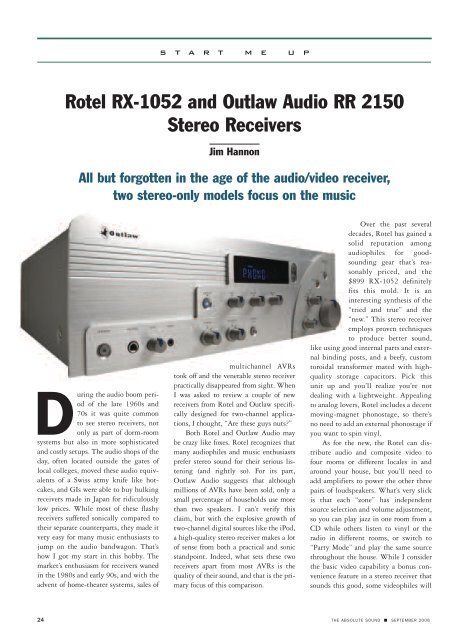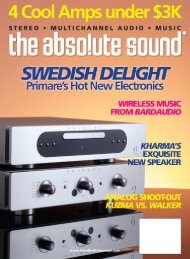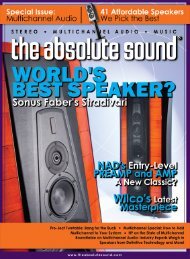The Cutting Edge
The Cutting Edge
The Cutting Edge
You also want an ePaper? Increase the reach of your titles
YUMPU automatically turns print PDFs into web optimized ePapers that Google loves.
s t a r t m e u p<br />
Rotel RX-1052 and Outlaw Audio RR 2150<br />
Stereo Receivers<br />
Jim Hannon<br />
All but forgotten in the age of the audio/video receiver,<br />
two stereo-only models focus on the music<br />
During the audio boom period<br />
of the late 1960s and<br />
70s it was quite common<br />
to see stereo receivers, not<br />
only as part of dorm-room<br />
systems but also in more sophisticated<br />
and costly setups. <strong>The</strong> audio shops of the<br />
day, often located outside the gates of<br />
local colleges, moved these audio equivalents<br />
of a Swiss army knife like hotcakes,<br />
and GIs were able to buy hulking<br />
receivers made in Japan for ridiculously<br />
low prices. While most of these flashy<br />
receivers suffered sonically compared to<br />
their separate counterparts, they made it<br />
very easy for many music enthusiasts to<br />
jump on the audio bandwagon. That’s<br />
how I got my start in this hobby. <strong>The</strong><br />
market’s enthusiasm for receivers waned<br />
in the 1980s and early 90s, and with the<br />
advent of home-theater systems, sales of<br />
multichannel AVRs<br />
took off and the venerable stereo receiver<br />
practically disappeared from sight. When<br />
I was asked to review a couple of new<br />
receivers from Rotel and Outlaw specifically<br />
designed for two-channel applications,<br />
I thought, “Are these guys nuts”<br />
Both Rotel and Outlaw Audio may<br />
be crazy like foxes. Rotel recognizes that<br />
many audiophiles and music enthusiasts<br />
prefer stereo sound for their serious listening<br />
(and rightly so). For its part,<br />
Outlaw Audio suggests that although<br />
millions of AVRs have been sold, only a<br />
small percentage of households use more<br />
than two speakers. I can’t verify this<br />
claim, but with the explosive growth of<br />
two-channel digital sources like the iPod,<br />
a high-quality stereo receiver makes a lot<br />
of sense from both a practical and sonic<br />
standpoint. Indeed, what sets these two<br />
receivers apart from most AVRs is the<br />
quality of their sound, and that is the primary<br />
focus of this comparison.<br />
Over the past several<br />
decades, Rotel has gained a<br />
solid reputation among<br />
audiophiles for goodsounding<br />
gear that’s reasonably<br />
priced, and the<br />
$899 RX-1052 definitely<br />
fits this mold. It is an<br />
interesting synthesis of the<br />
“tried and true” and the<br />
“new.” This stereo receiver<br />
employs proven techniques<br />
to produce better sound,<br />
like using good internal parts and external<br />
binding posts, and a beefy, custom<br />
toroidal transformer mated with highquality<br />
storage capacitors. Pick this<br />
unit up and you’ll realize you’re not<br />
dealing with a lightweight. Appealing<br />
to analog lovers, Rotel includes a decent<br />
moving-magnet phonostage, so there’s<br />
no need to add an external phonostage if<br />
you want to spin vinyl.<br />
As for the new, the Rotel can distribute<br />
audio and composite video to<br />
four rooms or different locales in and<br />
around your house, but you’ll need to<br />
add amplifiers to power the other three<br />
pairs of loudspeakers. What’s very slick<br />
is that each “zone” has independent<br />
source selection and volume adjustment,<br />
so you can play jazz in one room from a<br />
CD while others listen to vinyl or the<br />
radio in different rooms, or switch to<br />
“Party Mode” and play the same source<br />
throughout the house. While I consider<br />
the basic video capability a bonus convenience<br />
feature in a stereo receiver that<br />
sounds this good, some videophiles will<br />
24 THE ABSOLUTE SOUND ■ SEPTEMBER 2006










